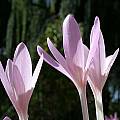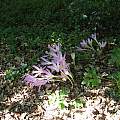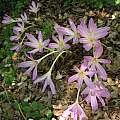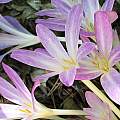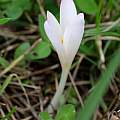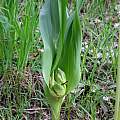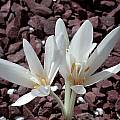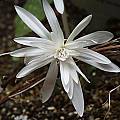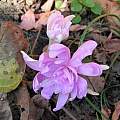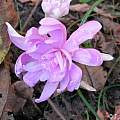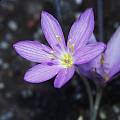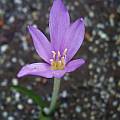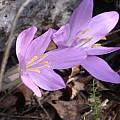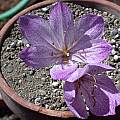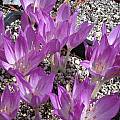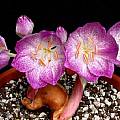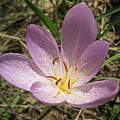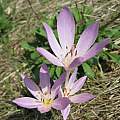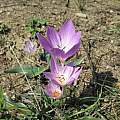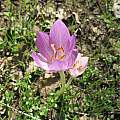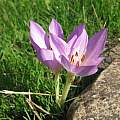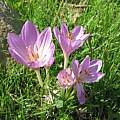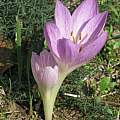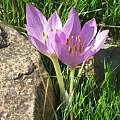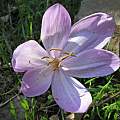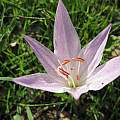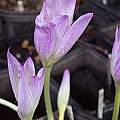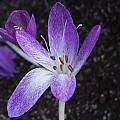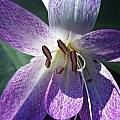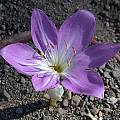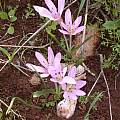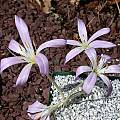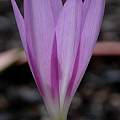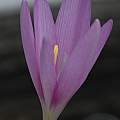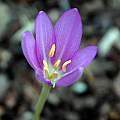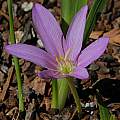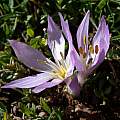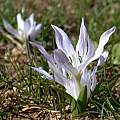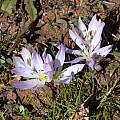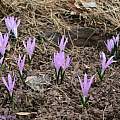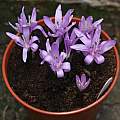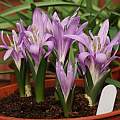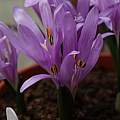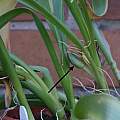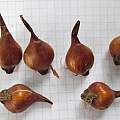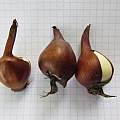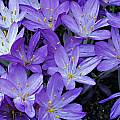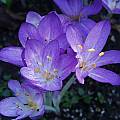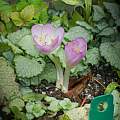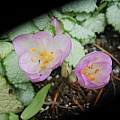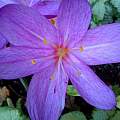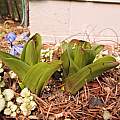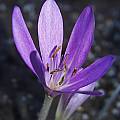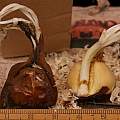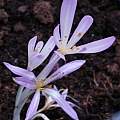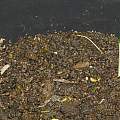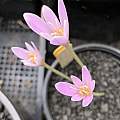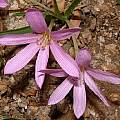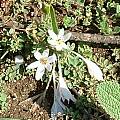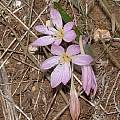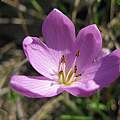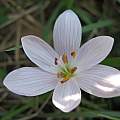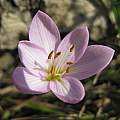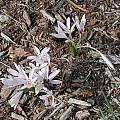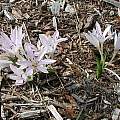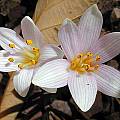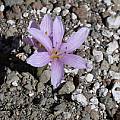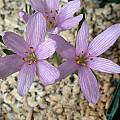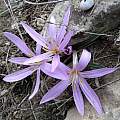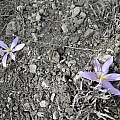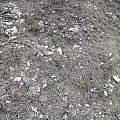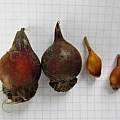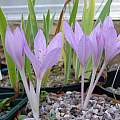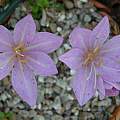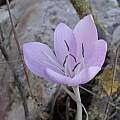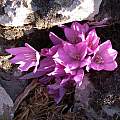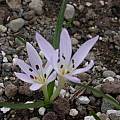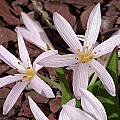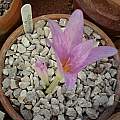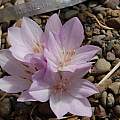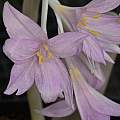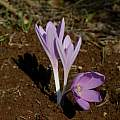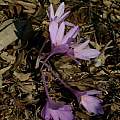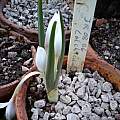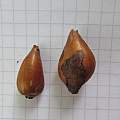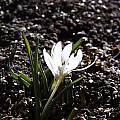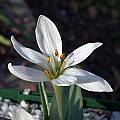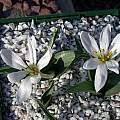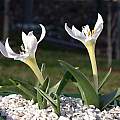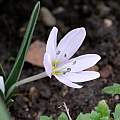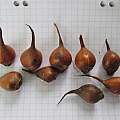Colchicum is a large genus in the Colchicaceae family found in Europe, North Africa and western to central Asia. Species are all winter growers, but they flower both in autumn and spring. Some of the autumn species flower before their leaves appear. Colchicum species a through h are found on this wiki page.
Colchicum index - Colchicum a-h – Colchicum i-r – Colchicum s-z - Colchicum hybrids – Androcymbium - Bulbocodium - Merendera
Colchicum x agrippinum see Colchicum Hybrids
Colchicum antilibanoticum Gomb. is a species native to Israel. Photo by Gideon Pisanty.
Colchicum autumnale L. is an early fall blooming species with small pink-purplish flowers that is a common meadow plant in Europe. Photo 1 was taken by John Lonsdale. Photos 2-4 were taken by Nhu Nguyen at the UC Botanical Garden. Photos 5-6 by Martin Bohnet show a white specimen in habitat and the seeds in May, both on the Swabian Jura.
Colchicum autumnale 'Album' is a white cultivar. Photo by John Lonsdale
Colchicum autumnale 'Alboplenum' is a double white garden selection. Photo by Arnold Trachtenberg
Colchicum autumnale 'Pleniflorum' is a double pink variety. Photos by Janos Agoston
Colchicum baytopiorum C.D.Brickell from Turkey where it is found in rocky scrub has purplish-pink non-tessellated flowers. Photos by Arnold Trachtenberg. The last photo by Jane McGary was taken in the wild, showing this species growing in the Roman-era ruins of Termessos near Antalya, southwestern Turkey.
Colchicum bivonae Guss. is native from Sicily to NW. Turkey. The first plant picture below, grown from wild-collected seed, is an example of the pure species Colchicum bivonae, which is a parent of many of the large-flowered Colchicum hybrids, often in crosses with Colchicum speciosum. Colchicum bivonae contributes the tessellation (checkering) to these hybrids. The second photo shows a deep-colored colchicum that lost its label thanks to a flock of crows a few years ago. It may be 'Vesta'. Photos 1,2 by Jane McGary. Photo 3 by Bill Dijk.
A series of photos in habitat by Angelo Porcelli, in Basilicata - Southern Italy, showing a wide range of forms, with round tepals or pointed, more or less dark and tessellated. This is rarely seen on the cultivated ones, being usually clones.
Colchicum bivonae 'Apollo' This handsomely tessellated cultivar seems to be fairly reliable in my Maryland garden. About twenty years ago I received what was probably the same plant under the now discredited name Colchicum bowlesianum B.L.Burtt. Photo by Wayne Crist of a plant in the garden of Jim McKenney.
Photos by Arnold Trachtenberg of plants received as Colchicum sibthorpii Baker which is considered in 2023 by most authorities to be a synonym of this species.
Colchicum boissieri Orph. is found in stony places in Greece and Turkey. Jane McGary gave tips on growing it on the PBS list:
"Almost uniquely in the genus, C. bossieri increases by stolon-like offsets that extend horizontally from the parent corm. The corms lie horizontally in the soil. Mature corms (which are still quite small) have a flat part from which the roots extend down, and the "foot" extends sideways from that. If you got these from the BX, you should be able to discern the side with the roots and place it downward. The white tip of the side extension is not the top. If your corms are too small to show the roots, lay them horizontally and let them figure it out, as they will. Planting depth would depend on your climate, but they don't grow deeply here, where winter lows are around 20 degrees F. They increase quickly, so don't expect to leave them in a small pot for more than two years. This species tolerates a long, dry summer."
Photos by Jane McGary and John Lonsdale. Photo #2 shows this species in the wild on the Mani Peninsula, southern Greece, in late October.
Photos from Mary Sue Ittner are of plants grown in Northern California. The first three show flowers blooming in October 2011 on an unusually cold day for that time of year they partially open. The last was taken on a sunny day several years earlier.
Colchicum brachyphyllum Boiss. & Hausskn. is a species that flowers with the leaves, from Israel. It is considered by Kew to be Colchicum szovitsii subsp. brachyphyllum(Boiss. & Hausskn.) K.Perss. with a range from Turkey to Jordan. Photos by Gideon Pisanty.
Colchicum bulbocodium Ker Gawl, syn. Bulbocodium vernum L., syn. Colchicum vernum (L.) Stef., is a species of European mountains from the Pyrenees and Alps to Austria in open alpine meadows. Commonly called "spring meadow saffron", it flowers in early spring, before much foliage has appeared and is about 4 inches high. There are three recognized subspecies. Note: Unlike Crocus sativus, the saffron Crocus, all parts are poisonous. This species prefers full sun to partial shade and well-drained soil; WHZ 3-8. It was introduced to English gardens from Spain around 1629. First photo by Judy Glattstein, remainder by David Pilling of bulbs in a 5" plant pot. Photo four shows that 3 or more flowers emerge from each set of leaves. Photo five illustrates that a couple of months after the flowers die back the stem elongates and a seed pod is formed. Seeds are short lived when stored dry, germination requires a cold period.
Photo of corms by Dr. Dimitri Zubov:
Colchicum bulbocodium subsp. versicolor (Ker Gawl.) K.Perss., syn. Bulbocodium versicolor (Ker Gawl.) Spreng. is one of the subspecies. Photo of the corm of a polyploid clone from Ukraine by Dr. Dimitri Zubov.
Colchicum × byzantinum Ker Gawl see Colchicum Hybrids
Colchicum cilicicum (Boiss.) Dammer is another species described as native to Turkey, Lebanon, and Syria with pinkish-purple flowers that can be grown in open sunny borders. The first two photos by Arnold Trachtenberg. The remaining photos by Travis Owen show flowers and emerging leaves, where it grows in harmony with deadnettle (Lamium maculatum).
The first photo was taken by Arnold Trachtenberg and the remainder by David Pilling of plants grown as Colchicum tenorei Parl., a fall blooming species from Italy which in 2023 is considered by many authorities to be a synonym of Colchicum cilicicum even though it is geographically distant. It has been described as rosy pink with the purple styles distinguishing it from other forms of this species.
Colchicum corsicum Baker. Photo by Pamela Harlow of plants grown from Archibald seed.
Colchicum cupanii Guss. is one of the smaller species, bearing 2-6 flowers and a couple of small leaves at the same time. Photos in habitat in Apulia-Italy by Angelo Porcelli, showing colour variants.
The first two photos below by Mark McDonough were taken on November 13, 2005. Notice the brave bumblebee in the first photo. The third photo was taken by John Lonsdale.
The first picture from Jane McGary is of a form purchased from Monocot Nursery in England as Colchicum cupanii subsp. bertolonii. It is an example of the smaller Colchicum species (cf. Colchicum hungaricum). This subspecies is not recognized by all and is considered to be subspecies cupanii by some. Another synonym is Colchicum bertolonii. The second photo by John Lonsdale is of another form he received as Colchicum cupanii ssp pulverulentum, another subspecies either not generally accepted or considered to be ssp. cupanii.
Colchicum eichleri (Regel) K.Perss. (syn. Bulbocodium eichleri Regel, Merendera eichleri (Regel) Boiss.) is native to central and eastern Caucasus. The first three photos from iNaturalist were taken by mallaliev in February in southern Russia and shared under a CC BY-NC license. The last photo of corms from the Azerbaijan Democratic Republic provided by Dr. Dimitri Zubov.
Colchicum feinbruniae K.Perss. is a fall blooming species endemic to Israel, Syria, and Lebanon. It has pink flowers with a blurred checkered pattern. It was named after the late Prof. Naomi Feinbrun, one of Israel's greatest botanists and a world specialist of bulbs. Photos by Peter Taggart.
Photos of wild plants in Israel by Gideon Pisanty.
Colchicum glossophyllum Heldr. ex Halácsy is a small species that blooms early. Kew considers it to be Colchicum cupanii subsp. glossophyllum (Heldr.) Rouy. Jane McGary comments: "however, as you can see in the photo, the leaves are much broader and longer at anthesis than is typical of Colchicum cupanii as I have seen it. The deep purple anthers are quite striking." Photos by Jane McGary and John Lonsdale.
Colchicum graecum K.Perss. is native to Greece. It is an early flowering species with rose pink faintly tessellated flowers. Photo from Peter Taggart.
Colchicum hierosolymitanum Feinbrun is a species of moderate size, named for its native region around Jerusalem. The photographed plant is one of a group grown from seed collected in the wild by Michael Salmon in the 1990. Growing in a roofed raised bed of coarse sand over loam in Portland, Oregon, these plants flower annually in October and often set seed. The first photo by Jane McGary. The second from Arnold Trachtenberg who said: "This one flowered while still in the basement for its summer rest."
Photos of wild plants in Israel by Gideon Pisanty.
Colchicum hirsutum Stef. is a species of southeast Turkey that flowers in late winter, early spring. First photo from Peter Taggart. Second photo by Dr. Dimitri Zubov, Turkey.
Colchicum hungaricum Janka is a very early spring blooming species with white or pinkish-lilac flowers. Photos by Arnold Trachtenberg and John Lonsdale.
Colchicum hungaricum 'Velebit Star' is a non-clonal strain from the Velebit Mountains in Croatia, advertised as flowering white with rarely pinkish individuals. Martin Bohnet's specimen turned out to show a very delicate lavender veining. Photo of corms by Dr. Dimitri Zubov.
Colchicum index - Colchicum a-h – Colchicum i-r – Colchicum s-z - Colchicum Hybrids – Androcymbium - Bulbocodium - Merendera

